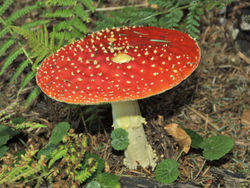Opisthokonta
The opisthokonts (Greek: ὀπίσθω- (opisthō-) = "rear, posterior" + κοντός (kontos) = "pole" i.e. flagellum) are a broad group of eukaryotes, including both the animal and fungus kingdoms, together with the phylum Choanozoa and Mesomycetozoa of the protist "kingdom". Both genetic and ultrastructural studies strongly support that opisthokonts form a monophyletic group.Many protists are now considered opisthokonts.
"Opisthokonta" and "Fungi/Metazoa group" are sometimes considered synonymous.
Flagella
One common characteristic is that flagellate cells, such as most animal sperm and chytrid spores, propel themselves with a single posterior flagellum. This gives the groups its name.
Opisthokont Fossil range: Neoproterozoic - Recent |
|
 |
|
Amanita muscaria |
|
In contrast, flagellate cells in other eukaryote groups propel themselves with one or more anterior flagella.
History
The close relationship between animals and fungi was suggested by Cavalier-Smith in 1987, who used the informal name opisthokonta (the formal name has been used for the chytrids), and was confirmed by later genetic studies. Early phylogenies placed them near the plants and other groups that have mitochondria with flat cristae, but this character varies.
Cavalier-Smith and Stechmann argue that the uniciliate eukaryotes such as opisthokonts and Amoebozoa, collectively called unikonts, split off from the other biciliate eukaryotes, called bikonts, shortly after they evolved.
Taxonomy
|
References
| - | Shalchian-Tabrizi K, Minge MA, Espelund M, et al (2008). "Multigene phylogeny of choanozoa and the origin of animals". PLoS ONE 3 (5): e2098. |
| - | Steenkamp ET, Wright J, Baldauf SL (January 2006). "The protistan origins of animals and fungi". Mol. Biol. Evol. 23 (1): 93–106. |
| - | Cavalier-Smith, T. (1987). "The origin of fungi and pseudofungi". in Rayner, Alan D. M. (ed.). Evolutionary biology of Fungi. Cambridge: Cambridge Univ. Press. pp. 339–353. |
| - | Wainright PO, Hinkle G, Sogin ML, Stickel SK (April 1993). "Monophyletic origins of the metazoa: an evolutionary link with fungi". Science (journal) 260 (5106): 340–2. |
| - | Stechmann, A.; Cavalier-Smith, T. (2002). "Rooting the eukaryote tree by using a derived gene fusion". Science 297: 89–91. |
| - | Eichinger, L.; Pachebat, J.A.; Glöckner, G.; Rajandream, M.A.; Sucgang, R.; Berriman, M.; Song, J.; Olsen, R.; Szafranski, K.; Xu, Q.; Others, (2005). "The genome of the social amoeba Dictyostelium discoideum". Nature 435 (7038): 43-57. |
| - | Steenkamp, E.T.; Wright, J.; Baldauf, S.L. (2006). "The Protistan Origins of Animals and Fungi". Molecular Biology and Evolution 23 (1): 93-106. |




